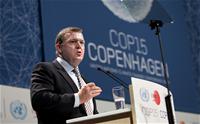Why reaching a legally binding agreement in Copenhagen is difficult?
Adelina Marini, December 11, 2009
 An answer to this question give Uri Dadush and Vera Eidelman from the Carnegie Endowment for International Peace. They make a comparison between Copenhagen and the lessons from Global Trade Reform or, to put it otherwise - globalisation. They say that reaching a legally binding multilateral agreement for carbon emissions will not only not be possible in Copenhagen but that such a deal is not likely anytime soon.
An answer to this question give Uri Dadush and Vera Eidelman from the Carnegie Endowment for International Peace. They make a comparison between Copenhagen and the lessons from Global Trade Reform or, to put it otherwise - globalisation. They say that reaching a legally binding multilateral agreement for carbon emissions will not only not be possible in Copenhagen but that such a deal is not likely anytime soon.
The trade experience shows that far-reaching reform can take place even in the absence of a global deal. Countries should recognize their self-interest in reforming, and the largest countries can lead the way through unilateral measures, as well as bilateral and regional deals. In the meantime, the authors warn that efforts such as border carbon tax should be avoided.
Uri Dadush and Vera Eidelman also say that the main obstacles for reaching a global binding agreement are very similar to those for a global free trade. First, much like a multilateral agreement on trade liberalization, a global agreement on emissions reductions would require countries to cede sovereignty on a strategic economic issue—something they are understandably reluctant to do.
Another problem is that multilateral negotiations reflect the particular development of some of 192 countries participating in the Copenhagen conference. In the case of climate change, because advanced countries have higher carbon emissions per capita while developing countries have higher emissions growth rates, the former call for limits on growth, while the latter call for large cuts in levels in the advanced countries. Because advanced countries are overwhelmingly responsible for today’s high carbon concentration, developing countries are even more reluctant to act and instead argue that developed countries should provide them with financial and technological assistance.
Similar differences existed between developed and developing countries with respect to tariff cuts; in order to protect infant industries and retain policy space in the event of shocks that they were ill-equipped to manage, developing countries were generally more resistant to reductions.
As with free trade, though the benefits of carbon cuts are widely understood, the actual process through which the economy will adapt to them is not. Besides, the timing and extent of climate change remain enormously uncertain.
Finally, similar to trade liberalization, controlling emissions will have important distributional  effects, as some sectors and regions emit more than others, and some are more dependent on non-renewable energy. Such differences greatly complicate the political economy of reform.
effects, as some sectors and regions emit more than others, and some are more dependent on non-renewable energy. Such differences greatly complicate the political economy of reform.
In conclusion, the authors from Carnegie Endowment for International Peace say that even if Copenhagen fails to close on a binding global deal, hope is not lost. Rather, through autonomous reforms and deals among like-minded countries—which may eventually be consolidated at the multilateral level—the world has a productive path to follow toward solving the planet’s most pressing challenge.
 | © White House press service
| © White House press service | © COP15
| © COP15 | © COP15
| © COP15